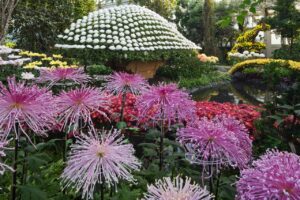
The art of training Japanese chrysanthemums to form various shapes and patterns, is on display once again in “Kiku: Spotlight on Tradition,” at the New York Botanical Garden in the Bronx through Nov. 12.
Visitors can marvel at this year’s kiku collection in the Bourke-Sullivan Display House of the Nolen Greenhouses for Living Collections. This intimate snapshot of a generations-old artform showcases the dedication and expertise of the horticulturists at NYBG, as well as the rich cultural significance of kiku in Japanese history. Botanical Garden experts work up to 11 months each year to grow, train and shape the chrysanthemums. Cultivated from tiny cuttings, the plants are pinched back, tied to frames and carefully nurtured. Flower buds develop as the autumn nights grow longer, and in October the plants burst into bloom, a true celebration of the changing of the seasons.
A variety of kiku styles are featured, including small and large kengai (“Cascade”), ogiku (“Triple Stem”), edo varieties trained in the shino-tsukuri (“Driving Rain”) style and the impressive dome-shaped ozukuri (“Thousand Bloom”). Informal training styles on display will include a variety of shapes such as cones, walls and a large bonsai tree – all made of chrysanthemums. The diversity of flowers on view embraces the 13 classes of chrysanthemum, including traditional Japanese flower styles such as choji (anemone), ise/saga (brush and thistle), hosokuda (spiders), ichimonji (semi-double), and the classic, daisy-like hlgo.
For more, click here.






















